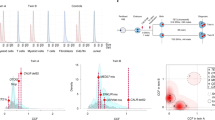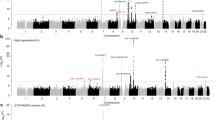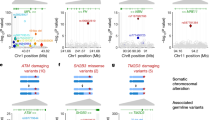Abstract
Identical twins have provided unique insights on timing or sequence of genetic events in acute lymphoblastic leukaemia (ALL). To date, this has mainly focused on ALL with MLL or ETV6-RUNX1 fusions, with hyperdiploid ALL remaining less well characterised. We examined three pairs of monozygotic twins, two concordant and one discordant for hyperdiploid ALL, for single-nucleotide polymorphism (SNP)-defined copy number alterations (CNAs), IGH/L plus TCR gene rearrangements and mutations in NRAS, KRAS, FLT3 and PTPN11 genes. We performed whole exome sequencing in one concordant twin pair. Potential ‘driver’ CNAs were low, 0–3 per case, and all were different within a pair. One patient had an NRAS mutation that was lacking from leukaemic cells of the twin sibling. By exome sequencing, there were 12 nonsynonymous mutations found in one twin and 5 in the other, one of which in SCL44A2 was shared or identical. Concordant pairs had some identical IGH/L and TCR rearrangements. In the twin pair with discordant hyperdiploid ALL, the healthy co-twin had persistent low level hyperdiploid CD19+ cells that lacked a CNA present in the ALL cells of her sibling. From these data, we propose that hyperdiploid ALL arises in a pre-B cell in utero and mutational changes necessary for clinical ALL accumulate subclonally and postnatally.
This is a preview of subscription content, access via your institution
Access options
Subscribe to this journal
Receive 12 print issues and online access
$259.00 per year
only $21.58 per issue
Buy this article
- Purchase on Springer Link
- Instant access to full article PDF
Prices may be subject to local taxes which are calculated during checkout





Similar content being viewed by others
References
Swerdlow SH CE, Harris NL, Jaffe ES, Pileri SA, Stein H, Thiele J et al. WHO Classification of Tumours of Haematopoietic and Lymphoid Tissues. IARC Press: Lyon, France, 2008.
Harrison CJ, Haas O, Harbott J, Biondi A, Stanulla M, Trka J et al. Detection of prognostically relevant genetic abnormalities in childhood B-cell precursor acute lymphoblastic leukaemia: recommendations from the Biology and Diagnosis Committee of the International Berlin-Frankfurt-Munster study group. Br J Haematol 2010; 151: 132–142.
Kaneko Y, Hayashi Y, Sakurai M . Chromosomal findings and their correlation to prognosis in acute lymphocytic leukemia. Cancer Genet Cytogenet 1981; 4: 227–235.
Pui CH, Raimondi SC, Dodge RK, Rivera GK, Fuchs LA, Abromowitch M et al. Prognostic importance of structural chromosomal abnormalities in children with hyperdiploid (greater than 50 chromosomes) acute lymphoblastic leukemia. Blood 1989; 73: 1963–1967.
Dastugue N, Suciu S, Plat G, Speleman F, Cave H, Girard S et al. Hyperdiploidy with 58-66 chromosomes in childhood B-acute lymphoblastic leukemia is highly curable: 58951 CLG-EORTC results. Blood 2013; 121: 2415–2423.
Moorman AV, Richards SM, Martineau M, Cheung KL, Robinson HM, Jalali GR et al. Outcome heterogeneity in childhood high-hyperdiploid acute lymphoblastic leukemia. Blood 2003; 102: 2756–2762.
Paulsson K, Forestier E, Andersen MK, Autio K, Barbany G, Borgstrom G et al. High modal number and triple trisomies are highly correlated favorable factors in childhood B-cell precursor high hyperdiploid acute lymphoblastic leukemia treated according to the NOPHO ALL 1992/2000 protocols. Haematologica 2013; 98: 1424–1432.
Paulsson K, Forestier E, Lilljebjorn H, Heldrup J, Behrendtz M, Young BD et al. Genetic landscape of high hyperdiploid childhood acute lymphoblastic leukemia. Proc Natl Acad Sci USA 2010; 107: 21719–21724.
Balatzenko G, Guenova M, Kalinova I, Belcheva M, Hristozova H, Kaleva V . Simultaneous occurrence of ETV6-RUNX1 and BCR-ABL1 (e1a2) transcripts in a child with B-cell acute lymphoblastic leukemia. Cancer Genet 2013.
Heerema NA, Sather HN, Sensel MG, Zhang T, Hutchinson RJ, Nachman JB et al. Prognostic impact of trisomies of chromosomes 10, 17, and 5 among children with acute lymphoblastic leukemia and high hyperdiploidy (> 50 chromosomes). J Clin Oncol 2000; 18: 1876–1887.
Paulsson K, Cazier JB, Macdougall F, Stevens J, Stasevich I, Vrcelj N et al. Microdeletions are a general feature of adult and adolescent acute lymphoblastic leukemia: unexpected similarities with pediatric disease. Proc Natl Acad Sci USA 2008; 6105: 6708–6713.
Davidsson J, Paulsson K, Lindgren D, Lilljebjorn H, Chaplin T, Forestier E et al. Relapsed childhood high hyperdiploid acute lymphoblastic leukemia: presence of preleukemic ancestral clones and the secondary nature of microdeletions and RTK-RAS mutations. Leukemia 2010; 24: 924–931.
Paulsson K, Horvat A, Strombeck B, Nilsson F, Heldrup J, Behrendtz M et al. Mutations of FLT3, NRAS, KRAS, and PTPN11 are frequent and possibly mutually exclusive in high hyperdiploid childhood acute lymphoblastic leukemia. Genes Chromosomes Cancer 2008; 47: 26–33.
Wiemels JL, Kang M, Chang JS, Zheng L, Kouyoumji C, Zhang L et al. Backtracking RAS mutations in high hyperdiploid childhood acute lymphoblastic leukemia. Blood Cells Mol Dis 2010; 45: 186–191.
Inthal A, Zeitlhofer P, Zeginigg M, Morak M, Grausenburger R, Fronkova E et al. CREBBP HAT domain mutations prevail in relapse cases of high hyperdiploid childhood acute lymphoblastic leukemia. Leukemia 2012; 26: 1797–1803.
Greaves MF, Maia AT, Wiemels JL, Ford AM . Leukemia in twins: lessons in natural history. Blood 2003; 1102: 2321–2333.
Bateman CM, Colman SM, Chaplin T, Young BD, Eden TO, Bhakta M et al. Acquisition of genome-wide copy number alterations in monozygotic twins with acute lymphoblastic leukemia. Blood 2010; 115: 3553–3558.
Faderl S, Jeha S, Kantarjian HM . The biology and therapy of adult acute lymphoblastic leukemia. Cancer 2003; 198: 1337–1354.
Maia AT, Tussiwand R, Cazzaniga G, Rebulla P, Colman S, Biondi A et al. Identification of preleukemic precursors of hyperdiploid acute lymphoblastic leukemia in cord blood. Genes Chromosomes Cancer 2004; 40: 38–43.
Gupta M, Young BD . Application of SNP genotype arrays to determine somatic changes in cancer. Methods Mol Biol 2009; 538: 179–206.
van Dongen JJ, Langerak AW, Bruggemann M, Evans PA, Hummel M, Lavender FL et al. Design and standardization of PCR primers and protocols for detection of clonal immunoglobulin and T-cell receptor gene recombinations in suspect lymphoproliferations: report of the BIOMED-2 Concerted Action BMH4-CT98-3936. Leukemia 2003; 17: 2257–2317.
Langerak AW, Groenen PJ, Bruggemann M, Beldjord K, Bellan C, Bonello L et al. EuroClonality/BIOMED-2 guidelines for interpretation and reporting of Ig/TCR clonality testing in suspected lymphoproliferations. Leukemia 2012; 26: 2159–2171.
van der Velden VH, Cazzaniga G, Schrauder A, Hancock J, Bader P, Panzer-Grumayer ER et al. Analysis of minimal residual disease by Ig/TCR gene rearrangements: guidelines for interpretation of real-time quantitative PCR data. Leukemia 2007; 21: 604–611.
Chong IY, Cunningham D, Barber LJ, Campbell J, Chen L, Kozarewa I et al. The genomic landscape of oesophagogastric junctional adenocarcinoma. J Pathol 2013; 231: 301–310.
McKenna A, Hanna M, Banks E, Sivachenko A, Cibulskis K, Kernytsky A et al. The Genome Analysis Toolkit: a MapReduce framework for analyzing next-generation DNA sequencing data. Genome Res 2010; 20: 1297–1303.
Welch JS, Ley TJ, Link DC, Miller CA, Larson DE, Koboldt DC et al. The origin and evolution of mutations in acute myeloid leukemia. Cell 2012; 150: 264–278.
Mullighan CG, Goorha S, Radtke I, Miller CB, Coustan-Smith E, Dalton JD et al. Genome-wide analysis of genetic alterations in acute lymphoblastic leukaemia. Nature 2007; 446: 758–764.
Csinady E, van der Velden VH, Joas R, Fischer S, de Vries JF, Beverloo HB et al. Chromosome 14 copy number-dependent IGH gene rearrangement patterns in high hyperdiploid childhood B-cell precursor ALL: implications for leukemia biology and minimal residual disease analysis. Leukemia 2009; 23: 870–876.
Szczepanski T, Willemse MJ, van Wering ER, van Weerden JF, Kamps WA, van Dongen JJ . Precursor-B-ALL with D(H)-J(H) gene rearrangements have an immature immunogenotype with a high frequency of oligoclonality and hyperdiploidy of chromosome 14. Leukemia 2001; 15: 1415–1423.
Hong D, Gupta R, Ancliff P, Atzberger A, Brown J, Soneji S et al. Initiating and cancer-propagating cells in TEL-AML1-associated childhood leukemia. Science 2008; 18319: 336–339.
Cazzaniga G, van Delft FW, Lo Nigro L, Ford AM, Score J, Iacobucci I et al. Developmental origins and impact of BCR-ABL1 fusion and IKZF1 deletions in monozygotic twins with Ph+ acute lymphoblastic leukemia. Blood 2011; 118: 5559–5564.
Paulsson K, Johansson B . High hyperdiploid childhood acute lymphoblastic leukemia. Genes Chromosomes Cancer 2009; 48: 637–660.
Lin YC, Jhunjhunwala S, Benner C, Heinz S, Welinder E, Mansson R et al. A global network of transcription factors, involving E2A, EBF1 and Foxo1, that orchestrates B cell fate. Nat Immunol 2010; 11: 635–643.
Ma Y, Dobbins SE, Sherborne AL, Chubb D, Galbiati M, Cazzaniga G et al. Developmental timing of mutations revealed by whole-genome sequencing of twins with acute lymphoblastic leukemia. Proc Natl Acad Sci USA 2013; 110: 7429–7433.
Panzer-Grumayer ER, Fasching K, Panzer S, Hettinger K, Schmitt K, Stockler-Ipsiroglu S et al. Nondisjunction of chromosomes leading to hyperdiploid childhood B-cell precursor acute lymphoblastic leukemia is an early event during leukemogenesis. Blood 2002; 100: 347–349.
Matsuda A, Suzuki Y, Honda G, Muramatsu S, Matsuzaki O, Nagano Y et al. Large-scale identification and characterization of human genes that activate NF-kappaB and MAPK signaling pathways. Oncogene 2003; 22: 3307–3318.
Anderson K, Lutz C, van Delft FW, Bateman CM, Guo Y, Colman SM et al. Genetic variegation of clonal architecture and propagating cells in leukaemia. Nature 2011; 469: 356–361.
Potter NE, Ermini L, Papaemmanuil E, Cazzaniga G, Vijayaraghavan G, Titley I et al. Single-cell mutational profiling and clonal phylogeny in cancer. Genome Res 2013; 23: 2115–2125.
Maia AT, van der Velden VH, Harrison CJ, Szczepanski T, Williams MD, Griffiths MJ et al. Prenatal origin of hyperdiploid acute lymphoblastic leukemia in identical twins. Leukemia 2003; 17: 2202–2206.
Taub JW, Konrad MA, Ge Y, Naber JM, Scott JS, Matherly LH et al. High frequency of leukemic clones in newborn screening blood samples of children with B-precursor acute lymphoblastic leukemia. Blood 2002; 99: 2992–2996.
Acknowledgements
This work was supported by Leukaemia & Lymphoma Research (to CMB, MG, AMF and SMC), The Kay Kendall Leukaemia Fund (to MG, AMF and SMC) and The Institute of Cancer Research (to LK and MG). DA is supported by the International Society for Advancement of Cytometry. DA and the Institute of Cancer Research acknowledge the support of the European Commission under the Marie Curie Intra-European Fellowship Programme. The contents of this paper reflect only the authors’ views and not the views of the European Commission. We thank Dr Iwanka Kozarewa, ICR tumour profiling unit, colleagues in exome sequencing, the children and their families for allowing the storage of biological material for research and The UK Cell Bank for releasing biological material for this project. We also thank professor Anthony Moorman, Northern Institute for Cancer Research, Newcastle, UK, for providing cytogenetic data on the samples provided by the Cell Bank and Dr Kajsa Paulsson, Department of Clinical Genetics, Lund University, Sweden, for providing a personal communication with regard to hyperdiploid ALL sequencing data. This project was part of the EHA-ASH Translational Research Training in Hematology (TRTH) Programme and NIHR Clinical Fellowship for CMB.
Author contributions
CMB: conducted genetic analysis (SNP arrays, FISH) on samples and drafted paper; DA: carried out all IGH/L and TCR clonal analyses and helped draft paper; AMF: carried out candidate gene mutational screen; DW: carried out GeneScan profiling; SMC: preparation, storage and retrieval of cells, and assisted with FISH scoring; MM: provided clinical samples from twin pair; LK: supervised FISH studies; MG: designed study and drafted the paper.
Author information
Authors and Affiliations
Corresponding author
Ethics declarations
Competing interests
The authors declare no conflict of interest.
Additional information
Supplementary Information accompanies this paper on the Leukemia website
Supplementary information
Rights and permissions
About this article
Cite this article
Bateman, C., Alpar, D., Ford, A. et al. Evolutionary trajectories of hyperdiploid ALL in monozygotic twins. Leukemia 29, 58–65 (2015). https://doi.org/10.1038/leu.2014.177
Received:
Revised:
Accepted:
Published:
Issue Date:
DOI: https://doi.org/10.1038/leu.2014.177
This article is cited by
-
The Eμ-Ret mouse is a novel model of hyperdiploid B-cell acute lymphoblastic leukemia
Leukemia (2024)
-
Covert pre-leukaemic clones in healthy co-twins of patients with childhood acute lymphoblastic leukaemia
Leukemia (2023)
-
Clonal origin and development of high hyperdiploidy in childhood acute lymphoblastic leukaemia
Nature Communications (2023)
-
PersonALL: a genetic scoring guide for personalized risk assessment in pediatric B-cell precursor acute lymphoblastic leukemia
British Journal of Cancer (2023)
-
An alternative CYB5A transcript is expressed in aneuploid ALL and enriched in relapse
BMC Genomic Data (2022)



